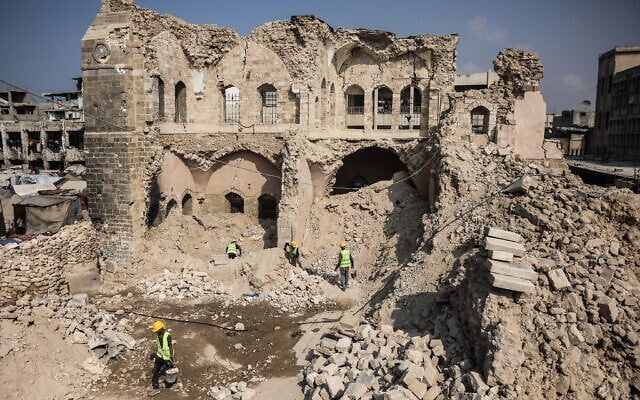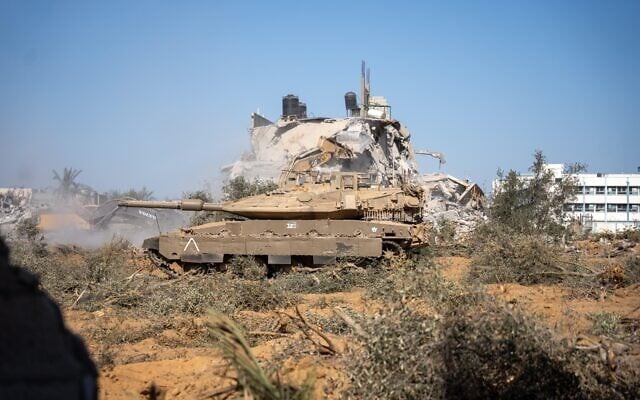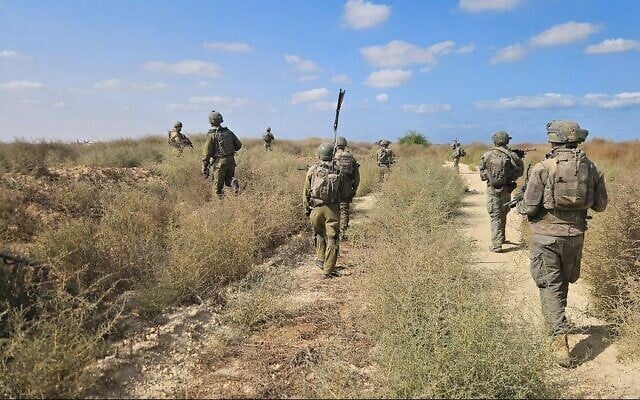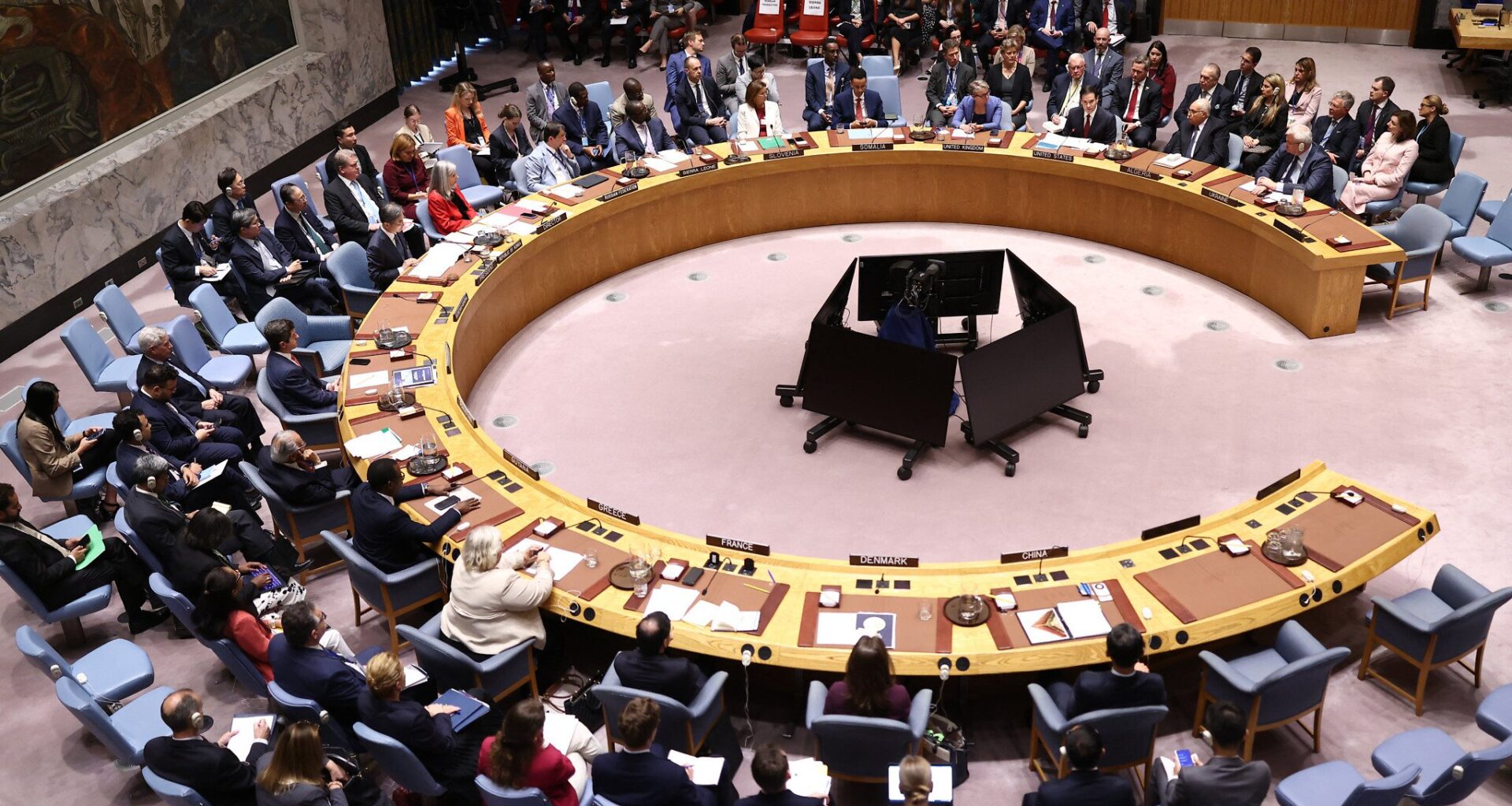The US on Thursday publicly called on fellow members of the UN Security Council to back Washington’s resolution to establish an International Stabilization Force to help secure postwar Gaza.
A statement from the US Mission to the UN said that the Trump administration has been working on the resolution for the past month, with input from Qatar, Egypt, Saudi Arabia, Turkey and the United Arab Emirates.
But the US proposal is facing opposition from Russia, China and some Arab countries, which have expressed unease about a yet-to-be established board that would temporarily govern the territory, and the lack of any transitional role for the Palestinian Authority.
Last week, the US mission began negotiations on a draft with fellow Security Council members in order to provide an international mandate for the ISF that would “begin a stable, secure, peaceful and prosperous future for Palestinians in Gaza, free of Hamas,” the US statement said.
“We urge the Security Council to seize this historic moment to pave a path towards enduring peace in the Middle East by supporting this resolution,” the US said.
Get The Times of Israel’s Daily Edition
by email and never miss our top stories
By signing up, you agree to the terms
The Chinese and the Russians — two veto-wielding members of the UN Security Council — have called for a “Board of Peace” under President Donald Trump’s ceasefire plan to be removed from the resolution entirely, according to four UN diplomats briefed on the matter who spoke to the Associated Press on condition of anonymity to discuss ongoing negotiations.

Illustrative: The UN Security Council holds an emergency meeting on the situation in Gaza at United Nations headquarters in New York on August 10, 2025. (John Lamparski / AFP)
In the latest draft released late Wednesday and obtained by The Associated Press, the US maintains the language around the board while providing further commitment to Palestinian self-determination, although the language remains weak.
Gaps emerge
While some of the responses to the US proposal reflect typical negotiations between countries — with detailed back-and-forth and revisions in language — the objection to the transitional board indicates that wide gaps have emerged between some members of the UN’s most powerful body and the US following more than two years of war.
At the same time, other members said quick action would avoid upending the progress toward peace, one diplomat said.
That was the message Thursday from the US mission to the UN, which said in a statement that the “attempts to sow discord” will have “grave, tangible and entirely avoidable consequences for Palestinians in Gaza.”

Workers start the rehabilitation on what remains of the Pasha Palace Museum, damaged by two years of fighting between Israel and Hamas, in Gaza City on November 11, 2025. (Omar al-Qataa/AFP)
Later on Thursday, Reuters reported that Russia had proposed its own draft for a UN resolution, in a challenge to the US effort.
Russia’s UN mission said in a note to Security Council members seen by Reuters that its “counter-proposal is inspired by the US draft.”
“The objective of our draft is to enable the Security Council to develop a balanced, acceptable, and unified approach toward achieving a sustainable cessation of hostilities,” the note said.
The US first circulated a draft resolution last week to the 15 members of the Security Council that would give a broad international mandate to the stabilization force to provide security in Gaza through the end of 2027, working with the yet-to-be-established Board of Peace. Arab and other countries that have expressed interest in participating in the force have indicated that such a mandate is necessary for them to contribute troops.
Russia, China and Algeria all voiced their opposition to that draft, and all but two of the other Security Council members submitted amendments, one diplomat said.
The sticking points surrounded the pathway to an independent Palestinian state and timeline for the withdrawal of Israeli forces from the Gaza Strip, according to two of the diplomats. The new draft this week responds to objections that the resolution didn’t envision a future independent Palestinian state — but without absolutes.
It says after reforms to the Palestinian Authority are “faithfully carried out and Gaza redevelopment has advanced, the conditions may be in place for a credible pathway to Palestinian self-determination and statehood.”
“The United States will establish a dialogue between Israel and the Palestinians to agree on a political horizon for peaceful and prosperous coexistence,” it adds.
The new draft adds that as the stabilization force “establishes control and stability,” the Israeli military will withdraw from the Gaza Strip. It reiterates that the step would be based on “standards, milestones and timeframes linked to demilitarization and agreed” by Israel, the stabilization force, the US and others.

Hamas terrorists guard an area where they are searching for the bodies of hostages with the help of the International Committee of the Red Cross (ICRC) in Gaza City on November 3, 2025. (Omar AL-QATTAA / AFP)
The United Arab Emirates, a major US ally in the peace negotiations, said publicly this week that it does not yet see a clear framework for the proposed stabilization force in Gaza and, under the current circumstances, will not take part in it.
Israeli Prime Minister Benjamin Netanyahu opposes Palestinian statehood and a Gaza governed by the Palestinian Authority, which runs parts of the West Bank. But the language in Trump’s plan seems to encourage a role for a Palestinian state.
Other countries on the Security Council have asked for further clarification on the Board of Peace, including who will be on it and how it will operate. The new draft did not make big changes regarding the board.
Countries have yet to publicly announce decisions to contribute troops to the ISF, amid fears the force will be tasked not just with securing Gaza’s borders, the distribution of humanitarian aid and day-to-day security functions, but also with entering into combat in order to disarm Hamas, which has shown no appetite for willingly giving up its arms as envisioned by Trump’s 20-point plan for ending the Gaza war.
Some countries push quick action to preserve momentum
Some council members say swift adoption of any proposal with the UN stamp of approval would be wise to keep up with the positive momentum on the ground, one diplomat said.
That diplomat and others said the Americans could get frustrated with the negotiations and decide to go forward unilaterally with a force from willing countries that would not have UN backing.
The US likely has three options going forward, another diplomat said: accept some meaningful amendments; put its draft to a vote, needing nine votes to pass and no veto by any of the Security Council’s permanent members; or bring together nations in a “coalition of the willing” outside the UN to take on and fund the stabilization of Gaza.

IDF troops operate on the eastern side of the Yellow Line in southern Gaza’s Khan Younis, in a handout photo issued on November 9, 2025. (Israel Defense Forces)
Whether Russia or China would veto a new draft if the US puts it to a vote without significant changes is uncertain.
The same diplomat said Moscow and Beijing had sought more than half the draft gutted and only want the stabilization force and for it to report to the Security Council.
‘Making progress’
The Times of Israel obtained and verified a copy of the US resolution’s text on Wednesday, and a Western diplomat said Washington is hoping to bring the matter to a vote in the coming days.
US Secretary of State Marco Rubio said Wednesday that Washington was “optimistic” about the chances of establishing the ISF in Gaza and was working on advancing its new draft through the UN Security Council to create the unit.
“We’re making good progress on the language of the resolution, and hopefully we’ll have action on it very soon. We don’t want to lose momentum on this,” Rubio told reporters in Canada, where he attended a G7 summit.

US Secretary of State Marco Rubio speaks during a news conference following his meeting with Prime Minister Benjamin Netanyahu at the Prime Minister’s office in Jerusalem, October 23, 2025. (Fadel Senna/Pool Photo via AP)
Asked whether the ISF will be a peace enforcer, rather than just a peacekeeping force, Rubio said, “It shouldn’t be a fighting force.”
He claimed that the “agreement that was signed and that all parties agreed to calls for the demilitarization of Hamas,” apparently referring to Trump’s 20-point plan for ending the Gaza war. But that agreement was not signed by any country. Dozens of countries did indeed provide varying levels of verbal support, and Netanyahu verbally accepted it in September.
However, the deal actually signed by Israel and Hamas on October 9 only dealt with an initial ceasefire, IDF pullback, hostage-prisoner swap and humanitarian aid provisions.
US officials have claimed that Hamas leaders pledged to disarm during a meeting they held with Trump’s top aides on the eve of the ceasefire signing. For its part, Hamas has publicly and repeatedly rejected the notion that it will disarm.

IDF soldiers in the Harel Brigade operate near the Yellow Line in Khan Younis, southern Gaza, in an image published on November 5, 2025. (Israel Defense Forces)
“As far as demilitarization is concerned. That’s a commitment Hamas made. That’s a commitment all of our partners on this deal made, and we expect that those countries… bring about pressure on Hamas to live up to that commitment,” Rubio said.
“The Israelis don’t want to govern Gaza, we don’t want to govern Gaza, and no country in the Middle East wants to govern Gaza. But it’ll take some time to build up that capability, and in the interim, someone has to provide security,” Rubio said, referring to the ISF.

